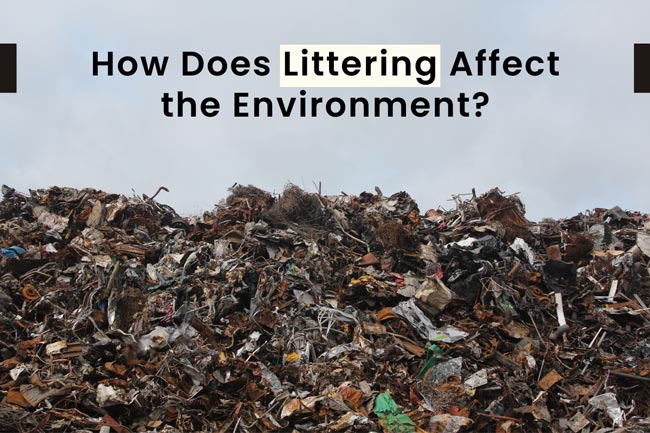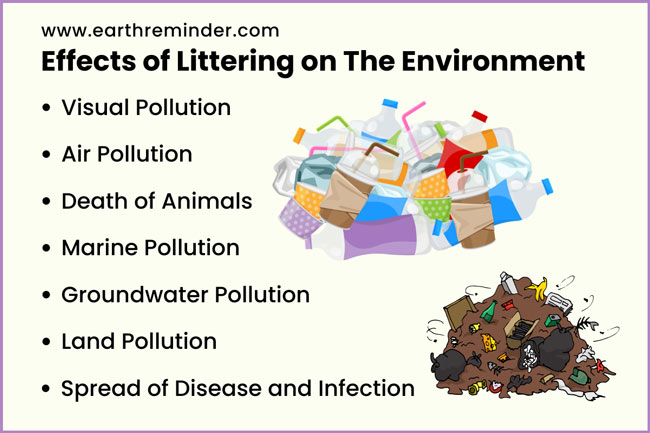How Does Littering Affect the Environment?
How Does Littering Affect the Environment?
In simple terms, Litter is any unwanted material that is either dumped or left behind in an uncontrolled manner. It is something that we all do. When we throw our trash away it doesn’t disappear. Instead, it becomes litter, and the more littered areas become, the harder it can be to effectively clean them up. That’s right, littering is actually a very bad thing for our environment.
The most harmful thing that people can do to the environment is littering. As we consume natural and manufactured items, we produce by-products that take their place in nature’s ecosystem. Non-biodegradable materials such as plastic trash, E-waste, glass, soil degradation materials like pesticides, etc. are generating major difficulties in our world. It can cause serious damage to our ecosystem.
Can we stop destroying the environment? Yes but, before we get to the answer, we need to figure out what’s causing the problem in the first place.
Research has shown that 19.9% of the litter on land is caused by unsecured items being transported in pickup trucks and trash receptacles. So, there must be a reason why individuals do such harm unintentionally. If you simplify this scenario, you will see that the major reason is people’s own laziness and lack of awareness.
Table of Contents
Effects of Littering on The Environment
If you look at the current scenario, you will notice that there is absolutely no element of the environment that is not affected by it. Litter can include items such as food wrappers, cigarette butts, cans, paper, plastic bottles, etc.
Do you know that yearly, more than 11 million premature deaths occur just because of pollution? And the damage is not just physical or chemical; in many cases, it has resulted in long-term damage that is extremely destructive to nature and the fauna.
Now, the Below points will further focus on how does littering affect the environment.
Air Pollution
Littering is one of the leading causes of air pollution. When litter decomposes, it releases hazardous chemicals into the air. As a result of exposure to these chemicals, many respiratory problems and even cancer can occur.
Research suggests that more than 40% of litter is burned out and mixed up with the air. And this is something we should be frightened about. Air is the reason for our existence, and if the air is getting polluted to this extent, it can cause serious health hazards to all human beings.
Marine Pollution
Litter causes marine pollution which is dangerous to both marine life and humans. Litter in the ocean can take hundreds of years to decompose, releasing harmful chemicals and pollutants into the water. It has become a big problem in the world’s oceans. Here, litter can come from ships, beaches, or even people throwing trash into the water.
Although rainwater washes out the litter we throw here and there. Most of the time, it mixes with water. Almost 80% of the polluted debris comes from the land to the waterbody, and this trash causes danger to all the living bodies on the earth.
On the other hand, the trash that humans throw away could harm marine life. For example, cigarette butts contain dangerous chemical components like arsenic and formaldehyde, which make the water poisonous and destroy the creatures in the aquatic environment.
In fact, 60% of water pollution is caused by litter, pet waste, and fertilizer. There are so many plastic materials that are floating in the ocean, and this is the reason that almost 1.6 million square kilometers between the California and Hawaii ocean currents contain a large “patch” known as “The Pacific Garbage Patch”.
Groundwater Pollution
Littering is one of the primary causes of groundwater pollution. When litter is left on the ground, it eventually finds its way into the water supply. This can contaminate the water and make it unsafe to drink. Many people in the world still rely on groundwater, and this garbage and chemical runoff readily mixes with the groundwater and pollutes it.
Land Pollution
Land Pollution due to littering is a huge problem in today’s society. The microparticles and chemicals created by litter decomposition cause a wide range of environmental issues. There is hardly any usable terrain that is free of the trash. The dangerous chemicals pollute the soil, and the toxins enter the food chain, causing harm to animals and human health.
Based on the conditions of the environment, Germany’s researchers estimated that microplastic pollution on land is 4-23 times more than marine microplastic pollution.
Visual Pollution
Litter causes visual pollution which makes our surroundings look dirty and unpleasant. Litter also attracts several animals and insects who may then leave behind their own waste, leading to even more pollution. It can be an eyesore in an area and make it look dirty even if it is otherwise clean.
Death of Animals
One of the most tragic consequences of litter is the death of animals. Animals can choke on or ingest litter (broken bits of glass, sharp items, etc.), which can lead to starvation, infection, and even death.
It can also entangle or trap animals, leaving them vulnerable to predators. Sadly, this happens all too often, and it’s one of the main reasons why littering is so dangerous. For example, marine species such as dolphins, turtles, whales, and others die from being entangled in plastic debris.
Each year almost approx. 100,000 marine mammals which include whales, seals, turtles, and dolphins die because of litter. Unbelievable right? But it is an unfortunate reality.
Toxins from the litter can produce a variety of symptoms in animals, including blood clots and major medical concerns. Litter waste has the potential to harm the entire riverbank and pond ecosystem.
Spread of Disease and Infection
Numerous germs and viruses can be found in the litter. When organic litter decomposes, it creates a breeding ground for multiple dangerous bacteria and viruses, which can spread directly and indirectly.
Different bacteria like Salmonella get aroused from them, which became a reason for some major illnesses, like typhoid fever, gastroenteritis, food poisoning, etc.
Animals that come into contact with litter can transfer bacteria and viruses to humans. In addition, rodents and other pests are attracted to areas where there is a lot of litter, increasing the risk of disease transmission.
Can We Prevent Littering?
As we can see, litter or trash can travel anywhere and everywhere, and the problems caused by this waste are enough to disrupt the healthy living of humankind. One thing we surely know is that a disturbed environment can never be a place for any healthy human being, and littering everywhere can never lead to a good healthy environment.
Among all, plastics have a huge role in causing an environmental hazard. Other than that, different non-biodegradable materials can cause massive harm to all the physical and aquatic habitats. The transportation of chemical pollutants produces so many toxic chemicals that cause severe problems in our life.
Research conducted in 2011 by the Keep Britain Tidy campaign shows the degree to which a person perceives enforcement as a threat strongly influences attitudes toward it, and many do not believe they will be penalized for environmental violations. Same research has shown that people are less likely to litter when they see or hear about fixed penalty notices.
As long as every member of society does not become aware of the serious issues caused by littering, this problem will never be solved. Also, the government must take necessary actions like providing the optimum number of garbage bins and regular waste material collection from any locality, etc.
If every single member of society becomes aware and determined, then only this problem can be solved, and we can save the Earth and its environment from future hazards.

